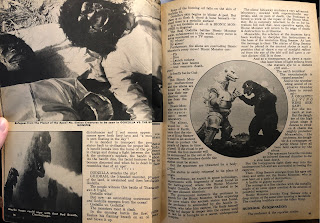directed by Noriaki Yuasa
Japan
81 minutes
3 stars out of 5
----
Masao and Jim are two boy scouts who have little in the way of personality other than that they love to play pranks. After a cold open (and a really potent title card drop) that establishes the alien invasion plot and shows us Gamera trying to stop it, we spend some time watching the two boys pull a fast one on their scout leader and some scientists with the end goal of getting them to let the kids pilot a submarine - if they can break it, then they're the only ones who'll be able to fix it, so the adults won't have any choice but to let them pilot it, right? It works, and after a disorienting ride, the scout leader and the head scientist turn the sub over to the boys, who use it to have a little race with Gamera. I really liked this part because if you think about it as coming chronologically after the cold open, it implies that Gamera fought with the Viras aliens, lost, came back to Earth to recuperate, and still made time to have an underwater race with a couple of kids and let them drive their mini submarine around his legs. What a champ.
But through a series of accidents, the boys end up abducted into the Viras mothership, and, by their quick thinking and Gamera's brute strength combined, have to figure out how to thwart the invasion.
The sequence of events where the boys rig up the submarine so that they're the only ones who'll know how to pilot it also establishes a theme that will run throughout the entire movie, and to an extent throughout all Gamera movies: adults do not know what they're doing, and most of the time they just get in the way. Kids in Gamera movies are treated as if they alone are capable of seeing the world in a way that adults just can't, and that's why I like these movies so much. They treat a child's perspective as a valuable and unique thing, not something of lesser value than an adult's way of navigating the world. I've read that this was something Noriaki Yuasa fully intended of his Gamera films - that adults know nothing, and children know everything.
When you think about it, the Viras aliens in their separate forms are an extension of the ignorant adults at the beginning of the film: they never let the kids get away with anything cool (their ship's replicator refuses to give them weapons), they try to make the kids do what they tell them to, they treat the kids like obstacles and want them to get out of the way. I like the individual Viras aliens, even though their combined form is one of my least favorite Gamera enemies. They're all wearing surgical scrubs for some reason. I have this weird idea that when they were observing Earth, they picked up our television signals, saw people in surgical scrubs cutting open, mutilating, and dealing apparent massive violence to other unconscious, helpless humans, and decided that wearing scrubs would be the best way to convey to humanity their intent to subjugate them by force.
This was made during bad financial times for Daiei, and has a third of the budget of its predecessor, Gamera vs. Gyaos. The film makes great use of what original material it's capable of concocting, but it does grind to a halt when the stock footage interlude hits. But aside from the stock footage, there is some real beauty to this. I was, even on this second viewing, still enraptured by the design of that spaceship. It's really something else, and not only is it aesthetically interesting, it's also technologically impressive: it can rearrange its segments and jettison damaged sections in response to an attack. I mentioned in my review of vs. Guiron that one of my favorite things was how the interior of the spaceship just has painted wooden floors, giving it this tangible, realistic feel, and I feel the same way about the interior of the Viras ship too. It looks like a big art exhibit.
I had a lot of fun with this one. I think it's one of the lesser-appreciated Showa Gamera movies, but I enjoyed it. I will say that it's a very uneven movie, though, and while the opening is a grand old time, it does struggle to regain its footing after the lengthy stock footage sequence, and never quite gets to the high point it hit at the beginning. It's still worthwhile for the art design if nothing else - these movies are so well-crafted that there's a timelessness to them that transcends their heavy 1960s aesthetic.






